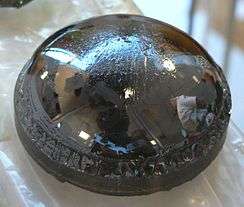Carbon
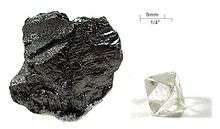 Graphite (left) and diamond (right), the two most well-known allotropes of carbon | |||||||||||||||||||||||||||||||||||||||||||||||||||||||||||||||||||||||||||||||||||||||||||||||||||||||||||||||||||||||||||||||||||||||||||||||||||||||||||||||||||||||||||||||||||||||||||||||||||||||||||||||||||||||||||||||||||||
|
Spectral lines of carbon | |||||||||||||||||||||||||||||||||||||||||||||||||||||||||||||||||||||||||||||||||||||||||||||||||||||||||||||||||||||||||||||||||||||||||||||||||||||||||||||||||||||||||||||||||||||||||||||||||||||||||||||||||||||||||||||||||||||
| General properties | |||||||||||||||||||||||||||||||||||||||||||||||||||||||||||||||||||||||||||||||||||||||||||||||||||||||||||||||||||||||||||||||||||||||||||||||||||||||||||||||||||||||||||||||||||||||||||||||||||||||||||||||||||||||||||||||||||||
|---|---|---|---|---|---|---|---|---|---|---|---|---|---|---|---|---|---|---|---|---|---|---|---|---|---|---|---|---|---|---|---|---|---|---|---|---|---|---|---|---|---|---|---|---|---|---|---|---|---|---|---|---|---|---|---|---|---|---|---|---|---|---|---|---|---|---|---|---|---|---|---|---|---|---|---|---|---|---|---|---|---|---|---|---|---|---|---|---|---|---|---|---|---|---|---|---|---|---|---|---|---|---|---|---|---|---|---|---|---|---|---|---|---|---|---|---|---|---|---|---|---|---|---|---|---|---|---|---|---|---|---|---|---|---|---|---|---|---|---|---|---|---|---|---|---|---|---|---|---|---|---|---|---|---|---|---|---|---|---|---|---|---|---|---|---|---|---|---|---|---|---|---|---|---|---|---|---|---|---|---|---|---|---|---|---|---|---|---|---|---|---|---|---|---|---|---|---|---|---|---|---|---|---|---|---|---|---|---|---|---|---|---|---|---|---|---|---|---|---|---|---|---|---|---|---|---|---|---|---|
| Name, symbol | carbon, C | ||||||||||||||||||||||||||||||||||||||||||||||||||||||||||||||||||||||||||||||||||||||||||||||||||||||||||||||||||||||||||||||||||||||||||||||||||||||||||||||||||||||||||||||||||||||||||||||||||||||||||||||||||||||||||||||||||||
| Pronunciation |
/ˈkɑːrbən/ KAR-bən | ||||||||||||||||||||||||||||||||||||||||||||||||||||||||||||||||||||||||||||||||||||||||||||||||||||||||||||||||||||||||||||||||||||||||||||||||||||||||||||||||||||||||||||||||||||||||||||||||||||||||||||||||||||||||||||||||||||
| Allotropes | graphite, diamond | ||||||||||||||||||||||||||||||||||||||||||||||||||||||||||||||||||||||||||||||||||||||||||||||||||||||||||||||||||||||||||||||||||||||||||||||||||||||||||||||||||||||||||||||||||||||||||||||||||||||||||||||||||||||||||||||||||||
| Appearance |
graphite: black diamond: clear | ||||||||||||||||||||||||||||||||||||||||||||||||||||||||||||||||||||||||||||||||||||||||||||||||||||||||||||||||||||||||||||||||||||||||||||||||||||||||||||||||||||||||||||||||||||||||||||||||||||||||||||||||||||||||||||||||||||
| Carbon in the periodic table | |||||||||||||||||||||||||||||||||||||||||||||||||||||||||||||||||||||||||||||||||||||||||||||||||||||||||||||||||||||||||||||||||||||||||||||||||||||||||||||||||||||||||||||||||||||||||||||||||||||||||||||||||||||||||||||||||||||
| |||||||||||||||||||||||||||||||||||||||||||||||||||||||||||||||||||||||||||||||||||||||||||||||||||||||||||||||||||||||||||||||||||||||||||||||||||||||||||||||||||||||||||||||||||||||||||||||||||||||||||||||||||||||||||||||||||||
| Atomic number (Z) | 6 | ||||||||||||||||||||||||||||||||||||||||||||||||||||||||||||||||||||||||||||||||||||||||||||||||||||||||||||||||||||||||||||||||||||||||||||||||||||||||||||||||||||||||||||||||||||||||||||||||||||||||||||||||||||||||||||||||||||
| Group, block | group 14 (carbon group), p-block | ||||||||||||||||||||||||||||||||||||||||||||||||||||||||||||||||||||||||||||||||||||||||||||||||||||||||||||||||||||||||||||||||||||||||||||||||||||||||||||||||||||||||||||||||||||||||||||||||||||||||||||||||||||||||||||||||||||
| Period | period 2 | ||||||||||||||||||||||||||||||||||||||||||||||||||||||||||||||||||||||||||||||||||||||||||||||||||||||||||||||||||||||||||||||||||||||||||||||||||||||||||||||||||||||||||||||||||||||||||||||||||||||||||||||||||||||||||||||||||||
| Element category | polyatomic nonmetal, sometimes considered a metalloid | ||||||||||||||||||||||||||||||||||||||||||||||||||||||||||||||||||||||||||||||||||||||||||||||||||||||||||||||||||||||||||||||||||||||||||||||||||||||||||||||||||||||||||||||||||||||||||||||||||||||||||||||||||||||||||||||||||||
| Standard atomic weight (Ar) | 12.011[1] (12.0096–12.0116)[2] | ||||||||||||||||||||||||||||||||||||||||||||||||||||||||||||||||||||||||||||||||||||||||||||||||||||||||||||||||||||||||||||||||||||||||||||||||||||||||||||||||||||||||||||||||||||||||||||||||||||||||||||||||||||||||||||||||||||
| Electron configuration | [He] 2s2 2p2 | ||||||||||||||||||||||||||||||||||||||||||||||||||||||||||||||||||||||||||||||||||||||||||||||||||||||||||||||||||||||||||||||||||||||||||||||||||||||||||||||||||||||||||||||||||||||||||||||||||||||||||||||||||||||||||||||||||||
per shell | 2, 4 | ||||||||||||||||||||||||||||||||||||||||||||||||||||||||||||||||||||||||||||||||||||||||||||||||||||||||||||||||||||||||||||||||||||||||||||||||||||||||||||||||||||||||||||||||||||||||||||||||||||||||||||||||||||||||||||||||||||
| Physical properties | |||||||||||||||||||||||||||||||||||||||||||||||||||||||||||||||||||||||||||||||||||||||||||||||||||||||||||||||||||||||||||||||||||||||||||||||||||||||||||||||||||||||||||||||||||||||||||||||||||||||||||||||||||||||||||||||||||||
| Phase | solid | ||||||||||||||||||||||||||||||||||||||||||||||||||||||||||||||||||||||||||||||||||||||||||||||||||||||||||||||||||||||||||||||||||||||||||||||||||||||||||||||||||||||||||||||||||||||||||||||||||||||||||||||||||||||||||||||||||||
| Sublimation point | 3915 K (3642 °C, 6588 °F) | ||||||||||||||||||||||||||||||||||||||||||||||||||||||||||||||||||||||||||||||||||||||||||||||||||||||||||||||||||||||||||||||||||||||||||||||||||||||||||||||||||||||||||||||||||||||||||||||||||||||||||||||||||||||||||||||||||||
| Density near r.t. |
amorphous: 1.8–2.1 g/cm3[3] graphite: 2.267 g/cm3 diamond: 3.515 g/cm3 | ||||||||||||||||||||||||||||||||||||||||||||||||||||||||||||||||||||||||||||||||||||||||||||||||||||||||||||||||||||||||||||||||||||||||||||||||||||||||||||||||||||||||||||||||||||||||||||||||||||||||||||||||||||||||||||||||||||
| Triple point | 4600 K, 10,800 kPa[4][5] | ||||||||||||||||||||||||||||||||||||||||||||||||||||||||||||||||||||||||||||||||||||||||||||||||||||||||||||||||||||||||||||||||||||||||||||||||||||||||||||||||||||||||||||||||||||||||||||||||||||||||||||||||||||||||||||||||||||
| Heat of fusion | graphite: 117 kJ/mol | ||||||||||||||||||||||||||||||||||||||||||||||||||||||||||||||||||||||||||||||||||||||||||||||||||||||||||||||||||||||||||||||||||||||||||||||||||||||||||||||||||||||||||||||||||||||||||||||||||||||||||||||||||||||||||||||||||||
| Molar heat capacity |
graphite: 8.517 J/(mol·K) diamond: 6.155 J/(mol·K) | ||||||||||||||||||||||||||||||||||||||||||||||||||||||||||||||||||||||||||||||||||||||||||||||||||||||||||||||||||||||||||||||||||||||||||||||||||||||||||||||||||||||||||||||||||||||||||||||||||||||||||||||||||||||||||||||||||||
| Atomic properties | |||||||||||||||||||||||||||||||||||||||||||||||||||||||||||||||||||||||||||||||||||||||||||||||||||||||||||||||||||||||||||||||||||||||||||||||||||||||||||||||||||||||||||||||||||||||||||||||||||||||||||||||||||||||||||||||||||||
| Oxidation states | +4, +3,[6] +2, +1,[7] 0, −1, −2, −3, −4[8] (a mildly acidic oxide) | ||||||||||||||||||||||||||||||||||||||||||||||||||||||||||||||||||||||||||||||||||||||||||||||||||||||||||||||||||||||||||||||||||||||||||||||||||||||||||||||||||||||||||||||||||||||||||||||||||||||||||||||||||||||||||||||||||||
| Electronegativity | Pauling scale: 2.55 | ||||||||||||||||||||||||||||||||||||||||||||||||||||||||||||||||||||||||||||||||||||||||||||||||||||||||||||||||||||||||||||||||||||||||||||||||||||||||||||||||||||||||||||||||||||||||||||||||||||||||||||||||||||||||||||||||||||
| Ionization energies |
1st: 1086.5 kJ/mol 2nd: 2352.6 kJ/mol 3rd: 4620.5 kJ/mol (more) | ||||||||||||||||||||||||||||||||||||||||||||||||||||||||||||||||||||||||||||||||||||||||||||||||||||||||||||||||||||||||||||||||||||||||||||||||||||||||||||||||||||||||||||||||||||||||||||||||||||||||||||||||||||||||||||||||||||
| Covalent radius |
sp3: 77 pm sp2: 73 pm sp: 69 pm | ||||||||||||||||||||||||||||||||||||||||||||||||||||||||||||||||||||||||||||||||||||||||||||||||||||||||||||||||||||||||||||||||||||||||||||||||||||||||||||||||||||||||||||||||||||||||||||||||||||||||||||||||||||||||||||||||||||
| Van der Waals radius | 170 pm | ||||||||||||||||||||||||||||||||||||||||||||||||||||||||||||||||||||||||||||||||||||||||||||||||||||||||||||||||||||||||||||||||||||||||||||||||||||||||||||||||||||||||||||||||||||||||||||||||||||||||||||||||||||||||||||||||||||
| Miscellanea | |||||||||||||||||||||||||||||||||||||||||||||||||||||||||||||||||||||||||||||||||||||||||||||||||||||||||||||||||||||||||||||||||||||||||||||||||||||||||||||||||||||||||||||||||||||||||||||||||||||||||||||||||||||||||||||||||||||
| Crystal structure |
graphite: simple hexagonal 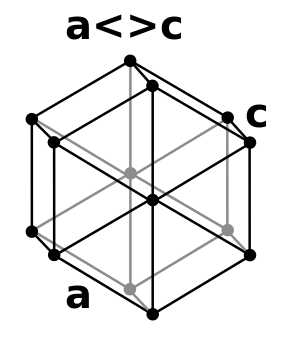
| ||||||||||||||||||||||||||||||||||||||||||||||||||||||||||||||||||||||||||||||||||||||||||||||||||||||||||||||||||||||||||||||||||||||||||||||||||||||||||||||||||||||||||||||||||||||||||||||||||||||||||||||||||||||||||||||||||||
| Crystal structure |
diamond: face-centered diamond-cubic  | ||||||||||||||||||||||||||||||||||||||||||||||||||||||||||||||||||||||||||||||||||||||||||||||||||||||||||||||||||||||||||||||||||||||||||||||||||||||||||||||||||||||||||||||||||||||||||||||||||||||||||||||||||||||||||||||||||||
| Speed of sound thin rod | diamond: 18,350 m/s (at 20 °C) | ||||||||||||||||||||||||||||||||||||||||||||||||||||||||||||||||||||||||||||||||||||||||||||||||||||||||||||||||||||||||||||||||||||||||||||||||||||||||||||||||||||||||||||||||||||||||||||||||||||||||||||||||||||||||||||||||||||
| Thermal expansion | diamond: 0.8 µm/(m·K) (at 25 °C)[9] | ||||||||||||||||||||||||||||||||||||||||||||||||||||||||||||||||||||||||||||||||||||||||||||||||||||||||||||||||||||||||||||||||||||||||||||||||||||||||||||||||||||||||||||||||||||||||||||||||||||||||||||||||||||||||||||||||||||
| Thermal conductivity |
graphite: 119–165 W/(m·K) diamond: 900–2300 W/(m·K) | ||||||||||||||||||||||||||||||||||||||||||||||||||||||||||||||||||||||||||||||||||||||||||||||||||||||||||||||||||||||||||||||||||||||||||||||||||||||||||||||||||||||||||||||||||||||||||||||||||||||||||||||||||||||||||||||||||||
| Electrical resistivity | graphite: 7.837 µΩ·m[10] | ||||||||||||||||||||||||||||||||||||||||||||||||||||||||||||||||||||||||||||||||||||||||||||||||||||||||||||||||||||||||||||||||||||||||||||||||||||||||||||||||||||||||||||||||||||||||||||||||||||||||||||||||||||||||||||||||||||
| Magnetic ordering | diamagnetic[11] | ||||||||||||||||||||||||||||||||||||||||||||||||||||||||||||||||||||||||||||||||||||||||||||||||||||||||||||||||||||||||||||||||||||||||||||||||||||||||||||||||||||||||||||||||||||||||||||||||||||||||||||||||||||||||||||||||||||
| Young's modulus | diamond: 1050 GPa[9] | ||||||||||||||||||||||||||||||||||||||||||||||||||||||||||||||||||||||||||||||||||||||||||||||||||||||||||||||||||||||||||||||||||||||||||||||||||||||||||||||||||||||||||||||||||||||||||||||||||||||||||||||||||||||||||||||||||||
| Shear modulus | diamond: 478 GPa[9] | ||||||||||||||||||||||||||||||||||||||||||||||||||||||||||||||||||||||||||||||||||||||||||||||||||||||||||||||||||||||||||||||||||||||||||||||||||||||||||||||||||||||||||||||||||||||||||||||||||||||||||||||||||||||||||||||||||||
| Bulk modulus | diamond: 442 GPa[9] | ||||||||||||||||||||||||||||||||||||||||||||||||||||||||||||||||||||||||||||||||||||||||||||||||||||||||||||||||||||||||||||||||||||||||||||||||||||||||||||||||||||||||||||||||||||||||||||||||||||||||||||||||||||||||||||||||||||
| Poisson ratio | diamond: 0.1[9] | ||||||||||||||||||||||||||||||||||||||||||||||||||||||||||||||||||||||||||||||||||||||||||||||||||||||||||||||||||||||||||||||||||||||||||||||||||||||||||||||||||||||||||||||||||||||||||||||||||||||||||||||||||||||||||||||||||||
| Mohs hardness |
graphite: 1–2 diamond: 10 | ||||||||||||||||||||||||||||||||||||||||||||||||||||||||||||||||||||||||||||||||||||||||||||||||||||||||||||||||||||||||||||||||||||||||||||||||||||||||||||||||||||||||||||||||||||||||||||||||||||||||||||||||||||||||||||||||||||
| CAS Number | 7440-44-0 | ||||||||||||||||||||||||||||||||||||||||||||||||||||||||||||||||||||||||||||||||||||||||||||||||||||||||||||||||||||||||||||||||||||||||||||||||||||||||||||||||||||||||||||||||||||||||||||||||||||||||||||||||||||||||||||||||||||
| History | |||||||||||||||||||||||||||||||||||||||||||||||||||||||||||||||||||||||||||||||||||||||||||||||||||||||||||||||||||||||||||||||||||||||||||||||||||||||||||||||||||||||||||||||||||||||||||||||||||||||||||||||||||||||||||||||||||||
| Discovery | Egyptians and Sumerians[12] (3750 BCE) | ||||||||||||||||||||||||||||||||||||||||||||||||||||||||||||||||||||||||||||||||||||||||||||||||||||||||||||||||||||||||||||||||||||||||||||||||||||||||||||||||||||||||||||||||||||||||||||||||||||||||||||||||||||||||||||||||||||
| Recognized as an element by | Antoine Lavoisier[13] (1789) | ||||||||||||||||||||||||||||||||||||||||||||||||||||||||||||||||||||||||||||||||||||||||||||||||||||||||||||||||||||||||||||||||||||||||||||||||||||||||||||||||||||||||||||||||||||||||||||||||||||||||||||||||||||||||||||||||||||
| Most stable isotopes of carbon | |||||||||||||||||||||||||||||||||||||||||||||||||||||||||||||||||||||||||||||||||||||||||||||||||||||||||||||||||||||||||||||||||||||||||||||||||||||||||||||||||||||||||||||||||||||||||||||||||||||||||||||||||||||||||||||||||||||
| |||||||||||||||||||||||||||||||||||||||||||||||||||||||||||||||||||||||||||||||||||||||||||||||||||||||||||||||||||||||||||||||||||||||||||||||||||||||||||||||||||||||||||||||||||||||||||||||||||||||||||||||||||||||||||||||||||||
Carbon (from Latin: carbo "coal") is a chemical element with symbol C and atomic number 6. It is nonmetallic and tetravalent—making four electrons available to form covalent chemical bonds. Three isotopes occur naturally, 12C and 13C being stable while 14C is radioactive, decaying with a half-life of about 5,730 years.[14] Carbon is one of the few elements known since antiquity.[15]
Carbon is the 15th most abundant element in the Earth's crust, and the fourth most abundant element in the universe by mass after hydrogen, helium, and oxygen. Carbon's abundance, its unique diversity of organic compounds, and its unusual ability to form polymers at the temperatures commonly encountered on Earth enables this element to serve as a common element of all known life. It is the second most abundant element in the human body by mass (about 18.5%) after oxygen.[16]
The atoms of carbon can be bonded together in different ways, termed allotropes of carbon. The best known are graphite, diamond, and amorphous carbon.[17] The physical properties of carbon vary widely with the allotropic form. For example, graphite is opaque and black while diamond is highly transparent. Graphite is soft enough to form a streak on paper (hence its name, from the Greek verb "γράφειν" which means "to write"), while diamond is the hardest naturally-occurring material known. Graphite is a good electrical conductor while diamond has a low electrical conductivity. Under normal conditions, diamond, carbon nanotubes, and graphene have the highest thermal conductivities of all known materials. All carbon allotropes are solids under normal conditions, with graphite being the most thermodynamically stable form. They are chemically resistant and require high temperature to react even with oxygen.
The most common oxidation state of carbon in inorganic compounds is +4, while +2 is found in carbon monoxide and transition metal carbonyl complexes. The largest sources of inorganic carbon are limestones, dolomites and carbon dioxide, but significant quantities occur in organic deposits of coal, peat, oil, and methane clathrates. Carbon forms a vast number of compounds, more than any other element, with almost ten million compounds described to date,[18] and yet that number is but a fraction of the number of theoretically possible compounds under standard conditions. For this reason, carbon has often been referred to as the "king of the elements".[19]
Characteristics
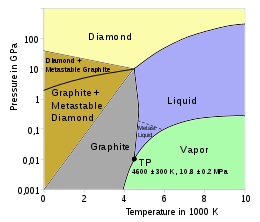
The allotropes of carbon include graphite, one of the softest known substances, and diamond, the hardest naturally occurring substance. It bonds readily with other small atoms including other carbon atoms, and is capable of forming multiple stable covalent bonds with suitable, multivalent atoms. Carbon is known to form almost ten million different compounds, a large majority of all chemical compounds.[18] Carbon also has the highest sublimation point of all elements. At atmospheric pressure it has no melting point as its triple point is at 10.8 ± 0.2 MPa and 4,600 ± 300 K (~4,330 °C or 7,820 °F),[4][5] so it sublimes at about 3,900 K.[20][21] Graphite is much more reactive than diamond at standard conditions, despite being more thermodynamically stable, as its delocalised pi system is much more vulnerable to attack. For example, graphite can be oxidised by hot concentrated nitric acid at standard conditions to mellitic acid, C6(CO2H)6, which preserves the hexagonal units of graphite while breaking up the larger structure.[22]
Carbon sublimes in a carbon arc which has a temperature of about 5,800 K (5,530 °C; 9,980 °F). Thus, irrespective of its allotropic form, carbon remains solid at higher temperatures than the highest melting point metals such as tungsten or rhenium. Although thermodynamically prone to oxidation, carbon resists oxidation more effectively than elements such as iron and copper that are weaker reducing agents at room temperature.
Carbon is the sixth element, with a ground-state electron configuration of 1s22s22p2, of which the four outer electrons are valence electrons. Its first four ionisation energies, 1086.5, 2352.6, 4620.5 and 6222.7 kJ/mol, are much higher than those of the heavier group 14 elements. The electronegativity of carbon is 2.5, significantly higher than the heavier group 14 elements (1.8–1.9), but close to most of the nearby nonmetals as well as some of the second- and third-row transition metals. Carbon's covalent radii are normally taken as 77.2 pm (C–C), 66.7 pm (C=C) and 60.3 pm (C≡C), although these may vary depending on coordination number and what the carbon is bonded to. In general, covalent radius decreases with lower coordination number and higher bond order.[23]
Carbon compounds form the basis of all known life on Earth, and the carbon-nitrogen cycle provides some of the energy produced by the Sun and other stars. Although it forms an extraordinary variety of compounds, most forms of carbon are comparatively unreactive under normal conditions. At standard temperature and pressure, it resists all but the strongest oxidizers. It does not react with sulfuric acid, hydrochloric acid, chlorine or any alkalis. At elevated temperatures, carbon reacts with oxygen to form carbon oxides, and will rob oxygen from metal oxides to leave the elemental metal. This exothermic reaction is used in the iron and steel industry to smelt iron and to control the carbon content of steel:
- Fe
3O
4 + 4 C(s) → 3 Fe(s) + 4 CO(g)
with sulfur to form carbon disulfide and with steam in the coal-gas reaction:
- C(s) + H2O(g) → CO(g) + H2(g).
Carbon combines with some metals at high temperatures to form metallic carbides, such as the iron carbide cementite in steel, and tungsten carbide, widely used as an abrasive and for making hard tips for cutting tools.
The system of carbon allotropes spans a range of extremes:
| Graphite is one of the softest materials known. | Synthetic nanocrystalline diamond is the hardest material known.[24] |
| Graphite is a very good lubricant, displaying superlubricity.[25] | Diamond is the ultimate abrasive. |
| Graphite is a conductor of electricity.[26] | Diamond is an excellent electrical insulator,[27] and has the highest breakdown electric field of any known material. |
| Some forms of graphite are used for thermal insulation (i.e. firebreaks and heat shields), but some other forms are good thermal conductors. | Diamond is the best known naturally occurring thermal conductor |
| Graphite is opaque. | Diamond is highly transparent. |
| Graphite crystallizes in the hexagonal system.[28] | Diamond crystallizes in the cubic system. |
| Amorphous carbon is completely isotropic. | Carbon nanotubes are among the most anisotropic materials known. |
Allotropes
Atomic carbon is a very short-lived species and, therefore, carbon is stabilized in various multi-atomic structures with different molecular configurations called allotropes. The three relatively well-known allotropes of carbon are amorphous carbon, graphite, and diamond. Once considered exotic, fullerenes are nowadays commonly synthesized and used in research; they include buckyballs,[29][30] carbon nanotubes,[31] carbon nanobuds[32] and nanofibers.[33][34] Several other exotic allotropes have also been discovered, such as lonsdaleite (questionable),[35] glassy carbon,[36] carbon nanofoam[37] and linear acetylenic carbon (carbyne).[38]
As of 2009, graphene appears to be the strongest material ever tested.[39] The process of separating it from graphite will require some further technological development before it is economical for industrial processes.[40] If successful, graphene could be used in the construction of an Earth to Space Elevator. It could also be used to safely store hydrogen for use in a hydrogen based engine in cars.[41]
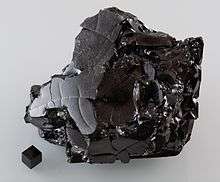
The amorphous form is an assortment of carbon atoms in a non-crystalline, irregular, glassy state, not held in a crystalline macrostructure. It is present as a powder, and is the main constituent of substances such as charcoal, lampblack (soot) and activated carbon. At normal pressures, carbon takes the form of graphite, in which each atom is bonded trigonally to three others in a plane composed of fused hexagonal rings, just like those in aromatic hydrocarbons.[42] The resulting network is 2-dimensional, and the resulting flat sheets are stacked and loosely bonded through weak van der Waals forces. This gives graphite its softness and its cleaving properties (the sheets slip easily past one another). Because of the delocalization of one of the outer electrons of each atom to form a π-cloud, graphite conducts electricity, but only in the plane of each covalently bonded sheet. This results in a lower bulk electrical conductivity for carbon than for most metals. The delocalization also accounts for the energetic stability of graphite over diamond at room temperature.

At very high pressures, carbon forms the more compact allotrope, diamond, having nearly twice the density of graphite. Here, each atom is bonded tetrahedrally to four others, forming a 3-dimensional network of puckered six-membered rings of atoms. Diamond has the same cubic structure as silicon and germanium, and because of the strength of the carbon-carbon bonds, it is the hardest naturally occurring substance measured by resistance to scratching. Contrary to the popular belief that "diamonds are forever", they are thermodynamically unstable under normal conditions and transform into graphite.[17] Due to a high activation energy barrier, the transition into graphite is so slow at normal temperature that it is unnoticeable. Under some conditions, carbon crystallizes as lonsdaleite, a hexagonal crystal lattice with all atoms covalently bonded and properties similar to those of diamond.[35]
Fullerenes are a synthetic crystalline formation with a graphite-like structure, but in place of hexagons, fullerenes are formed of pentagons (or even heptagons) of carbon atoms. The missing (or additional) atoms warp the sheets into spheres, ellipses, or cylinders. The properties of fullerenes (split into buckyballs, buckytubes, and nanobuds) have not yet been fully analyzed and represent an intense area of research in nanomaterials. The names "fullerene" and "buckyball" are given after Richard Buckminster Fuller, popularizer of geodesic domes, which resemble the structure of fullerenes. The buckyballs are fairly large molecules formed completely of carbon bonded trigonally, forming spheroids (the best-known and simplest is the soccerball-shaped C60 buckminsterfullerene).[29] Carbon nanotubes are structurally similar to buckyballs, except that each atom is bonded trigonally in a curved sheet that forms a hollow cylinder.[30][31] Nanobuds were first reported in 2007 and are hybrid bucky tube/buckyball materials (buckyballs are covalently bonded to the outer wall of a nanotube) that combine the properties of both in a single structure.[32]
Of the other discovered allotropes, carbon nanofoam is a ferromagnetic allotrope discovered in 1997. It consists of a low-density cluster-assembly of carbon atoms strung together in a loose three-dimensional web, in which the atoms are bonded trigonally in six- and seven-membered rings. It is among the lightest known solids, with a density of about 2 kg/m3.[43] Similarly, glassy carbon contains a high proportion of closed porosity,[36] but contrary to normal graphite, the graphitic layers are not stacked like pages in a book, but have a more random arrangement. Linear acetylenic carbon[38] has the chemical structure[38] -(C:::C)n-. Carbon in this modification is linear with sp orbital hybridization, and is a polymer with alternating single and triple bonds. This carbyne is of considerable interest to nanotechnology as its Young's modulus is forty times that of the hardest known material – diamond.[44]
In 2015, a team at the North Carolina State University announced the development of another allotrope they have dubbed Q-carbon, created by a high energy low duration laser pulse on amorphous carbon dust. Q-carbon is reported to exhibit ferromagetism, fluorescence, and a hardness superior to diamonds.[45]
Occurrence
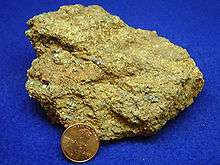

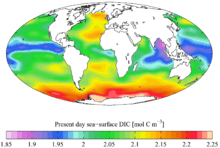
Carbon is the fourth most abundant chemical element in the universe by mass after hydrogen, helium, and oxygen. Carbon is abundant in the Sun, stars, comets, and in the atmospheres of most planets.[46] Some meteorites contain microscopic diamonds that were formed when the solar system was still a protoplanetary disk. Microscopic diamonds may also be formed by the intense pressure and high temperature at the sites of meteorite impacts.[47]
In 2014 NASA announced a greatly upgraded database for tracking polycyclic aromatic hydrocarbons (PAHs) in the universe. More than 20% of the carbon in the universe may be associated with PAHs, complex compounds of carbon and hydrogen without oxygen.[48] These compounds figure in the PAH world hypothesis where they are hypothesized to have a role in abiogenesis and formation of life. PAHs seem to have been formed "a couple of billion years" after the Big Bang, are widespread throughout the universe, and are associated with new stars and exoplanets.[46]
It has been estimated that the solid earth as a whole contains 730 ppm of carbon, with 2000 ppm in the core and 120 ppm in the combined mantle and crust.[49] Since the mass of the earth is 5.972×1024 kg, this would imply 4360 million gigatonnes of carbon. This is much more than the amount of carbon in the oceans or atmosphere (below).
In combination with oxygen in carbon dioxide, carbon is found in the Earth's atmosphere (approximately 810 gigatonnes of carbon) and dissolved in all water bodies (approximately 36,000 gigatonnes of carbon). Around 1,900 gigatonnes of carbon are present in the biosphere. Hydrocarbons (such as coal, petroleum, and natural gas) contain carbon as well. Coal "reserves" (not "resources") amount to around 900 gigatonnes with perhaps 18 000 Gt of resources.[50] Oil reserves are around 150 gigatonnes. Proven sources of natural gas are about 175 1012 cubic metres (containing about 105 gigatonnes of carbon), but studies estimate another 900 1012 cubic metres of "unconventional" deposits such as shale gas, representing about 540 gigatonnes of carbon.[51]
Carbon is also found in methane hydrates in polar regions and under the seas. Various estimates put this carbon between 500, 2500 Gt,[52] or 3000 Gt.[53]
In the past, quantities of hydrocarbons were greater. According to one source, in the period from 1751 to 2008 about 347 gigatonnes of carbon were released as carbon dioxide to the atmosphere from burning of fossil fuels.[54] Another source puts the amount added to the atmosphere for the period since 1750 at 879 Gt, and the total going to the atmosphere, sea, and land (such as peat bogs) at almost 2000 Gt.[55]
Carbon is a constituent (about 12% by mass) of the very large masses of carbonate rock (limestone, dolomite, marble and so on). Coal is very rich in carbon (anthracite contains 92–98%)[56] and is the largest commercial source of mineral carbon, accounting for 4,000 gigatonnes or 80% of fossil fuel.[57]
As for individual carbon allotropes, graphite is found in large quantities in the United States (mostly in New York and Texas), Russia, Mexico, Greenland, and India. Natural diamonds occur in the rock kimberlite, found in ancient volcanic "necks", or "pipes". Most diamond deposits are in Africa, notably in South Africa, Namibia, Botswana, the Republic of the Congo, and Sierra Leone. Diamond deposits have also been found in Arkansas, Canada, the Russian Arctic, Brazil, and in Northern and Western Australia. Diamonds are now also being recovered from the ocean floor off the Cape of Good Hope. Diamonds are found naturally, but about 30% of all industrial diamonds used in the U.S. are now manufactured.
Carbon-14 is formed in upper layers of the troposphere and the stratosphere at altitudes of 9–15 km by a reaction that is precipitated by cosmic rays.[58] Thermal neutrons are produced that collide with the nuclei of nitrogen-14, forming carbon-14 and a proton. As such, 1.2 × 1010% of atmospheric carbon dioxide contains carbon-14.[23]
Carbon-rich asteroids are relatively preponderant in the outer parts of the asteroid belt in our solar system. These asteroids have not yet been directly sampled by scientists. The asteroids can be used in hypothetical space-based carbon mining, which may be possible in the future, but is currently technologically impossible.[59]
Isotopes
Isotopes of carbon are atomic nuclei that contain six protons plus a number of neutrons (varying from 2 to 16). Carbon has two stable, naturally occurring isotopes.[14] The isotope carbon-12 (12C) forms 98.93% of the carbon on Earth, while carbon-13 (13C) forms the remaining 1.07%.[14] The concentration of 12C is further increased in biological materials because biochemical reactions discriminate against 13C.[60] In 1961, the International Union of Pure and Applied Chemistry (IUPAC) adopted the isotope carbon-12 as the basis for atomic weights.[61] Identification of carbon in nuclear magnetic resonance (NMR) experiments is done with the isotope 13C.
Carbon-14 (14C) is a naturally occurring radioisotope, created in the upper atmosphere (lower stratosphere and upper troposphere) by interaction of nitrogen with cosmic rays.[62] It is found in trace amounts on Earth of up to 1 part per trillion (0.0000000001%), mostly confined to the atmosphere and superficial deposits, particularly of peat and other organic materials.[63] This isotope decays by 0.158 MeV β− emission. Because of its relatively short half-life of 5730 years, 14C is virtually absent in ancient rocks. The amount of 14C in the atmosphere and in living organisms is almost constant, but decreases predictably in their bodies after death. This principle is used in radiocarbon dating, invented in 1949, which has been used extensively to determine the age of carbonaceous materials with ages up to about 40,000 years.[64][65]
There are 15 known isotopes of carbon and the shortest-lived of these is 8C which decays through proton emission and alpha decay and has a half-life of 1.98739x10−21 s.[66] The exotic 19C exhibits a nuclear halo, which means its radius is appreciably larger than would be expected if the nucleus were a sphere of constant density.[67]
Formation in stars
Formation of the carbon atomic nucleus requires a nearly simultaneous triple collision of alpha particles (helium nuclei) within the core of a giant or supergiant star which is known as the triple-alpha process, as the products of further nuclear fusion reactions of helium with hydrogen or another helium nucleus produce lithium-5 and beryllium-8 respectively, both of which are highly unstable and decay almost instantly back into smaller nuclei.[68] This happens in conditions of temperatures over 100 megakelvin and helium concentration that the rapid expansion and cooling of the early universe prohibited, and therefore no significant carbon was created during the Big Bang.
According to current physical cosmology theory, carbon is formed in the interiors of stars in the horizontal branch by the collision and transformation of three helium nuclei.[69] When those stars die as supernova, the carbon is scattered into space as dust. This dust becomes component material for the formation of second or third-generation star systems with accreted planets.[46][70] The Solar System is one such star system with an abundance of carbon, enabling the existence of life as we know it.
The CNO cycle is an additional fusion mechanisms that powers stars, wherein carbon operates as a catalyst.
Rotational transitions of various isotopic forms of carbon monoxide (for example, 12CO, 13CO, and 18CO) are detectable in the submillimeter wavelength range, and are used in the study of newly forming stars in molecular clouds.[71]
Carbon cycle
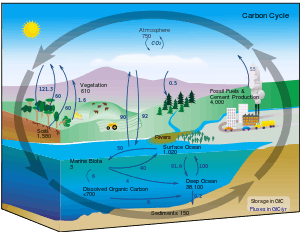
Under terrestrial conditions, conversion of one element to another is very rare. Therefore, the amount of carbon on Earth is effectively constant. Thus, processes that use carbon must obtain it from somewhere and dispose of it somewhere else. The paths of carbon in the environment form the carbon cycle. For example, photosynthetic plants draw carbon dioxide from the atmosphere (or seawater) and build it into biomass, as in the Calvin cycle, a process of carbon fixation. Some of this biomass is eaten by animals, while some carbon is exhaled by animals as carbon dioxide. The carbon cycle is considerably more complicated than this short loop; for example, some carbon dioxide is dissolved in the oceans; if bacteria do not consume it, dead plant or animal matter may become petroleum or coal, which releases carbon when burned.[72][73]
Compounds
Organic compounds


Carbon can form very long chains of interconnecting C-C bonds, a property that is called catenation. Carbon-carbon bonds are strong and stable. Through catenation, carbon forms a countless number of compounds. A tally of unique compounds shows that more contain carbon that those that do not. A similar claim can be made for hydrogen because most organic compounds also contain hydrogen.
The simplest form of an organic molecule is the hydrocarbon—a large family of organic molecules that are composed of hydrogen atoms bonded to a chain of carbon atoms. Chain length, side chains and functional groups all affect the properties of organic molecules.
Carbon occurs in all known organic life and is the basis of organic chemistry. When united with hydrogen, it forms various hydrocarbons that are important to industry as refrigerants, lubricants, solvents, as chemical feedstock for the manufacture of plastics and petrochemicals, and as fossil fuels.
When combined with oxygen and hydrogen, carbon can form many groups of important biological compounds including sugars, lignans, chitins, alcohols, fats, and aromatic esters, carotenoids and terpenes. With nitrogen it forms alkaloids, and with the addition of sulfur also it forms antibiotics, amino acids, and rubber products. With the addition of phosphorus to these other elements, it forms DNA and RNA, the chemical-code carriers of life, and adenosine triphosphate (ATP), the most important energy-transfer molecule in all living cells.
Inorganic compounds
Commonly carbon-containing compounds which are associated with minerals or which do not contain hydrogen or fluorine, are treated separately from classical organic compounds; the definition is not rigid (see reference articles above). Among these are the simple oxides of carbon. The most prominent oxide is carbon dioxide (CO2). This was once the principal constituent of the paleoatmosphere, but is a minor component of the Earth's atmosphere today.[74] Dissolved in water, it forms carbonic acid (H
2CO
3), but as most compounds with multiple single-bonded oxygens on a single carbon it is unstable.[75] Through this intermediate, though, resonance-stabilized carbonate ions are produced. Some important minerals are carbonates, notably calcite. Carbon disulfide (CS
2) is similar.[22]
The other common oxide is carbon monoxide (CO). It is formed by incomplete combustion, and is a colorless, odorless gas. The molecules each contain a triple bond and are fairly polar, resulting in a tendency to bind permanently to hemoglobin molecules, displacing oxygen, which has a lower binding affinity.[76][77] Cyanide (CN−), has a similar structure, but behaves much like a halide ion (pseudohalogen). For example, it can form the nitride cyanogen molecule ((CN)2), similar to diatomic halides. Other uncommon oxides are carbon suboxide (C
3O
2),[78] the unstable dicarbon monoxide (C2O),[79][80] carbon trioxide (CO3),[81][82] cyclopentanepentone (C5O5),[83] cyclohexanehexone (C6O6),[83] and mellitic anhydride (C12O9).
With reactive metals, such as tungsten, carbon forms either carbides (C4−) or acetylides (C2−
2) to form alloys with high melting points. These anions are also associated with methane and acetylene, both very weak acids. With an electronegativity of 2.5,[84] carbon prefers to form covalent bonds. A few carbides are covalent lattices, like carborundum (SiC), which resembles diamond. Nevertheless, even the most polar and salt-like of carbides are not completely ionic compounds.[85]
Organometallic compounds
Organometallic compounds by definition contain at least one carbon-metal bond. A wide range of such compounds exist; major classes include simple alkyl-metal compounds (for example, tetraethyllead), η2-alkene compounds (for example, Zeise's salt), and η3-allyl compounds (for example, allylpalladium chloride dimer); metallocenes containing cyclopentadienyl ligands (for example, ferrocene); and transition metal carbene complexes. Many metal carbonyls exist (for example, tetracarbonylnickel); some workers consider the carbon monoxide ligand to be purely inorganic, and not organometallic.
While carbon is understood to exclusively form four bonds, an interesting compound containing an octahedral hexacoordinated carbon atom has been reported. The cation of the compound is [(Ph3PAu)6C]2+. This phenomenon has been attributed to the aurophilicity of the gold ligands.[86]
History and etymology

The English name carbon comes from the Latin carbo for coal and charcoal,[87] whence also comes the French charbon, meaning charcoal. In German, Dutch and Danish, the names for carbon are Kohlenstoff, koolstof and kulstof respectively, all literally meaning coal-substance.
Carbon was discovered in prehistory and was known in the forms of soot and charcoal to the earliest human civilizations. Diamonds were known probably as early as 2500 BCE in China, while carbon in the form of charcoal was made around Roman times by the same chemistry as it is today, by heating wood in a pyramid covered with clay to exclude air.[88][89]
In 1722, René Antoine Ferchault de Réaumur demonstrated that iron was transformed into steel through the absorption of some substance, now known to be carbon.[90] In 1772, Antoine Lavoisier showed that diamonds are a form of carbon; when he burned samples of charcoal and diamond and found that neither produced any water and that both released the same amount of carbon dioxide per gram. In 1779,[91] Carl Wilhelm Scheele showed that graphite, which had been thought of as a form of lead, was instead identical with charcoal but with a small admixture of iron, and that it gave "aerial acid" (his name for carbon dioxide) when oxidized with nitric acid.[92] In 1786, the French scientists Claude Louis Berthollet, Gaspard Monge and C. A. Vandermonde confirmed that graphite was mostly carbon by oxidizing it in oxygen in much the same way Lavoisier had done with diamond.[93] Some iron again was left, which the French scientists thought was necessary to the graphite structure. In their publication they proposed the name carbone (Latin carbonum) for the element in graphite which was given off as a gas upon burning graphite. Antoine Lavoisier then listed carbon as an element in his 1789 textbook.[94]
A new allotrope of carbon, fullerene, that was discovered in 1985[95] includes nanostructured forms such as buckyballs and nanotubes.[29] Their discoverers – Robert Curl, Harold Kroto and Richard Smalley – received the Nobel Prize in Chemistry in 1996.[96] The resulting renewed interest in new forms lead to the discovery of further exotic allotropes, including glassy carbon, and the realization that "amorphous carbon" is not strictly amorphous.[36]
Production
Graphite
Commercially viable natural deposits of graphite occur in many parts of the world, but the most important sources economically are in China, India, Brazil and North Korea. Graphite deposits are of metamorphic origin, found in association with quartz, mica and feldspars in schists, gneisses and metamorphosed sandstones and limestone as lenses or veins, sometimes of a metre or more in thickness. Deposits of graphite in Borrowdale, Cumberland, England were at first of sufficient size and purity that, until the 19th century, pencils were made simply by sawing blocks of natural graphite into strips before encasing the strips in wood. Today, smaller deposits of graphite are obtained by crushing the parent rock and floating the lighter graphite out on water.[97]
There are three types of natural graphite—amorphous, flake or crystalline flake, and vein or lump. Amorphous graphite is the lowest quality and most abundant. Contrary to science, in industry "amorphous" refers to very small crystal size rather than complete lack of crystal structure. Amorphous is used for lower value graphite products and is the lowest priced graphite. Large amorphous graphite deposits are found in China, Europe, Mexico and the United States. Flake graphite is less common and of higher quality than amorphous; it occurs as separate plates that crystallized in metamorphic rock. Flake graphite can be four times the price of amorphous. Good quality flakes can be processed into expandable graphite for many uses, such as flame retardants. The foremost deposits are found in Austria, Brazil, Canada, China, Germany and Madagascar. Vein or lump graphite is the rarest, most valuable, and highest quality type of natural graphite. It occurs in veins along intrusive contacts in solid lumps, and it is only commercially mined in Sri Lanka.[97]
According to the USGS, world production of natural graphite was 1.1 million tonnes in 2010, to which China contributed 800,000 t, India 130,000 t, Brazil 76,000 t, North Korea 30,000 t and Canada 25,000 t. No natural graphite was reported mined in the United States, but 118,000 t of synthetic graphite with an estimated value of $998 million was produced in 2009.[97]
Diamond
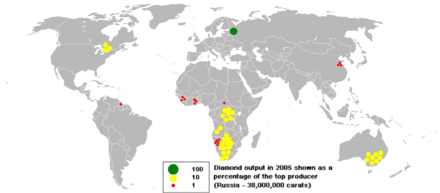
The diamond supply chain is controlled by a limited number of powerful businesses, and is also highly concentrated in a small number of locations around the world (see figure).
Only a very small fraction of the diamond ore consists of actual diamonds. The ore is crushed, during which care has to be taken in order to prevent larger diamonds from being destroyed in this process and subsequently the particles are sorted by density. Today, diamonds are located in the diamond-rich density fraction with the help of X-ray fluorescence, after which the final sorting steps are done by hand. Before the use of X-rays became commonplace, the separation was done with grease belts; diamonds have a stronger tendency to stick to grease than the other minerals in the ore.[98]
Historically diamonds were known to be found only in alluvial deposits in southern India.[99] India led the world in diamond production from the time of their discovery in approximately the 9th century BCE[100] to the mid-18th century AD, but the commercial potential of these sources had been exhausted by the late 18th century and at that time India was eclipsed by Brazil where the first non-Indian diamonds were found in 1725.[101]
Diamond production of primary deposits (kimberlites and lamproites) only started in the 1870s after the discovery of the Diamond fields in South Africa. Production has increased over time and now an accumulated total of 4.5 billion carats have been mined since that date.[102] About 20% of that amount has been mined in the last 5 years alone, and during the last ten years 9 new mines have started production while 4 more are waiting to be opened soon. Most of these mines are located in Canada, Zimbabwe, Angola, and one in Russia.[102]
In the United States, diamonds have been found in Arkansas, Colorado and Montana.[103][104] In 2004, a startling discovery of a microscopic diamond in the United States[105] led to the January 2008 bulk-sampling of kimberlite pipes in a remote part of Montana.[106]
Today, most commercially viable diamond deposits are in Russia, Botswana, Australia and the Democratic Republic of Congo.[107] In 2005, Russia produced almost one-fifth of the global diamond output, reports the British Geological Survey. Australia has the richest diamantiferous pipe with production reaching peak levels of 42 metric tons (41 long tons; 46 short tons) per year in the 1990s.[103] There are also commercial deposits being actively mined in the Northwest Territories of Canada, Siberia (mostly in Yakutia territory; for example, Mir pipe and Udachnaya pipe), Brazil, and in Northern and Western Australia.
Applications
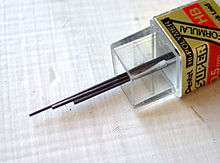
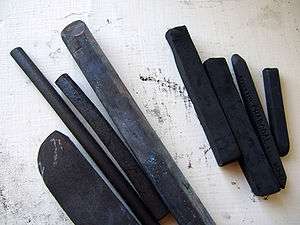

Carbon is essential to all known living systems, and without it life as we know it could not exist (see alternative biochemistry). The major economic use of carbon other than food and wood is in the form of hydrocarbons, most notably the fossil fuel methane gas and crude oil (petroleum). Crude oil is distilled in refineries by the petrochemical industry to produce gasoline, kerosene, and other products. Cellulose is a natural, carbon-containing polymer produced by plants in the form of wood, cotton, linen, and hemp. Cellulose is used primarily for maintaining structure in plants. Commercially valuable carbon polymers of animal origin include wool, cashmere and silk. Plastics are made from synthetic carbon polymers, often with oxygen and nitrogen atoms included at regular intervals in the main polymer chain. The raw materials for many of these synthetic substances come from crude oil.
The uses of carbon and its compounds are extremely varied. It can form alloys with iron, of which the most common is carbon steel. Graphite is combined with clays to form the 'lead' used in pencils used for writing and drawing. It is also used as a lubricant and a pigment, as a molding material in glass manufacture, in electrodes for dry batteries and in electroplating and electroforming, in brushes for electric motors and as a neutron moderator in nuclear reactors.
Charcoal is used as a drawing material in artwork, barbecue grilling, iron smelting, and in many other applications. Wood, coal and oil are used as fuel for production of energy and heating. Gem quality diamond is used in jewelry, and industrial diamonds are used in drilling, cutting and polishing tools for machining metals and stone. Plastics are made from fossil hydrocarbons, and carbon fiber, made by pyrolysis of synthetic polyester fibers is used to reinforce plastics to form advanced, lightweight composite materials.
Carbon fiber is made by pyrolysis of extruded and stretched filaments of polyacrylonitrile (PAN) and other organic substances. The crystallographic structure and mechanical properties of the fiber depend on the type of starting material, and on the subsequent processing. Carbon fibers made from PAN have structure resembling narrow filaments of graphite, but thermal processing may re-order the structure into a continuous rolled sheet. The result is fibers with higher specific tensile strength than steel.[108]
Carbon black is used as the black pigment in printing ink, artist's oil paint and water colours, carbon paper, automotive finishes, India ink and laser printer toner. Carbon black is also used as a filler in rubber products such as tyres and in plastic compounds. Activated charcoal is used as an absorbent and adsorbent in filter material in applications as diverse as gas masks, water purification, and kitchen extractor hoods, and in medicine to absorb toxins, poisons, or gases from the digestive system. Carbon is used in chemical reduction at high temperatures. Coke is used to reduce iron ore into iron (smelting). Case hardening of steel is achieved by heating finished steel components in carbon powder. Carbides of silicon, tungsten, boron and titanium, are among the hardest known materials, and are used as abrasives in cutting and grinding tools. Carbon compounds make up most of the materials used in clothing, such as natural and synthetic textiles and leather, and almost all of the interior surfaces in the built environment other than glass, stone and metal.
Diamonds
The diamond industry falls into two categories: one dealing with gem-grade diamonds and the other, with industrial-grade diamonds. While a large trade in both types of diamonds exists, the two markets act in dramatically different ways.
Unlike precious metals such as gold or platinum, gem diamonds do not trade as a commodity: there is a substantial mark-up in the sale of diamonds, and there is not a very active market for resale of diamonds.
Industrial diamonds are valued mostly for their hardness and heat conductivity, with the gemological qualities of clarity and color being mostly irrelevant. About 80% of mined diamonds (equal to about 100 million carats or 20 tonnes annually) are unsuitable for use as gemstones are relegated for industrial use (known as bort).[109] synthetic diamonds, invented in the 1950s, found almost immediate industrial applications; 3 billion carats (600 tonnes) of synthetic diamond is produced annually.[110]
The dominant industrial use of diamond is in cutting, drilling, grinding, and polishing. Most of these applications do not require large diamonds; in fact, most diamonds of gem-quality except for their small size can be used industrially. Diamonds are embedded in drill tips or saw blades, or ground into a powder for use in grinding and polishing applications.[111] Specialized applications include use in laboratories as containment for high pressure experiments (see diamond anvil cell), high-performance bearings, and limited use in specialized windows.[112][113] With the continuing advances in the production of synthetic diamonds, new applications are becoming feasible. Garnering much excitement is the possible use of diamond as a semiconductor suitable for microchips, and because of its exceptional heat conductance property, as a heat sink in electronics.[114]
Precautions

Pure carbon has extremely low toxicity to humans and can be handled and even ingested safely in the form of graphite or charcoal. It is resistant to dissolution or chemical attack, even in the acidic contents of the digestive tract. Consequently, once it enters into the body's tissues it is likely to remain there indefinitely. Carbon black was probably one of the first pigments to be used for tattooing, and Ötzi the Iceman was found to have carbon tattoos that survived during his life and for 5200 years after his death.[115] Inhalation of coal dust or soot (carbon black) in large quantities can be dangerous, irritating lung tissues and causing the congestive lung disease, coalworker's pneumoconiosis. Diamond dust used as an abrasive can harmful if ingested or inhaled. Microparticles of carbon are produced in diesel engine exhaust fumes, and may accumulate in the lungs.[116] In these examples, the harm may result from contaminants (e.g., organic chemicals, heavy metals) rather than from the carbon itself.
Carbon generally has low toxicity to life on Earth; but carbon nanoparticles are deadly to Drosophila.[117]
Carbon may burn vigorously and brightly in the presence of air at high temperatures. Large accumulations of coal, which have remained inert for hundreds of millions of years in the absence of oxygen, may spontaneously combust when exposed to air in coal mine waste tips, ship cargo holds and coal bunkers,[118][119] and storage dumps.
In nuclear applications where graphite is used as a neutron moderator, accumulation of Wigner energy followed by a sudden, spontaneous release may occur. Annealing to at least 250 °C can release the energy safely, although in the Windscale fire the procedure went wrong, causing other reactor materials to combust.
The great variety of carbon compounds include such lethal poisons as tetrodotoxin, the lectin ricin from seeds of the castor oil plant Ricinus communis, cyanide (CN−), and carbon monoxide; and such essentials to life as glucose and protein.
Bonding to carbon
| CH | He | ||||||||||||||||
| CLi | CBe | CB | CC | CN | CO | CF | Ne | ||||||||||
| CNa | CMg | CAl | CSi | CP | CS | CCl | CAr | ||||||||||
| CK | CCa | CSc | CTi | CV | CCr | CMn | CFe | CCo | CNi | CCu | CZn | CGa | CGe | CAs | CSe | CBr | CKr |
| CRb | CSr | CY | CZr | CNb | CMo | CTc | CRu | CRh | CPd | CAg | CCd | CIn | CSn | CSb | CTe | CI | CXe |
| CCs | CBa | CHf | CTa | CW | CRe | COs | CIr | CPt | CAu | CHg | CTl | CPb | CBi | CPo | CAt | Rn | |
| Fr | CRa | Rf | Db | CSg | Bh | Hs | Mt | Ds | Rg | Cn | Nh | Fl | Mc | Lv | Ts | Og | |
| ↓ | |||||||||||||||||
| CLa | CCe | CPr | CNd | CPm | CSm | CEu | CGd | CTb | CDy | CHo | CEr | CTm | CYb | CLu | |||
| Ac | CTh | CPa | CU | CNp | CPu | CAm | CCm | CBk | CCf | CEs | Fm | Md | No | Lr | |||
| Core organic chemistry | Many uses in chemistry |
| Academic research, but no widespread use | Bond unknown |
See also
References
- ↑ Conventional Atomic Weights 2013. Commission on Isotopic Abundances and Atomic Weights
- ↑ Standard Atomic Weights 2013. Commission on Isotopic Abundances and Atomic Weights
- ↑ Lide, D. R., ed. (2005). CRC Handbook of Chemistry and Physics (86th ed.). Boca Raton (FL): CRC Press. ISBN 0-8493-0486-5.
- 1 2 Haaland, D (1976). "Graphite-liquid-vapor triple point pressure and the density of liquid carbon". Carbon. 14 (6): 357. doi:10.1016/0008-6223(76)90010-5.
- 1 2 Savvatimskiy, A (2005). "Measurements of the melting point of graphite and the properties of liquid carbon (a review for 1963–2003)". Carbon. 43 (6): 1115. doi:10.1016/j.carbon.2004.12.027.
- ↑ "Fourier Transform Spectroscopy of the System of CP" (PDF). Retrieved 2007-12-06.
- ↑ "Fourier Transform Spectroscopy of the Electronic Transition of the Jet-Cooled CCI Free Radical" (PDF). Retrieved 2007-12-06.
- ↑ "Carbon: Binary compounds". Retrieved 2007-12-06.
- 1 2 3 4 5 Properties of diamond, Ioffe Institute Database
- ↑ "Material Properties- Misc Materials". www.nde-ed.org. Retrieved 12 November 2016.
- ↑ Magnetic susceptibility of the elements and inorganic compounds, in Handbook of Chemistry and Physics 81st edition, CRC press.
- ↑ "History of Carbon and Carbon Materials - Center for Applied Energy Research - University of Kentucky". Caer.uky.edu. Retrieved 2008-09-12.
- ↑ Senese, Fred (2000-09-09). "Who discovered carbon?". Frostburg State University. Retrieved 2007-11-24.
- 1 2 3 "Carbon – Naturally occurring isotopes". WebElements Periodic Table. Retrieved 2008-10-09.
- ↑ "History of Carbon". Retrieved 2013-01-10.
- ↑ "Biological Abundance of Elements". The Internet Encyclopedia of Science. Retrieved 2008-10-09.
- 1 2 "World of Carbon – Interactive Nano-visulisation in Science & Engineering Education (IN-VSEE)". Retrieved 2008-10-09.
- 1 2 Chemistry Operations (December 15, 2003). "Carbon". Los Alamos National Laboratory. Archived from the original on 2008-09-13. Retrieved 2008-10-09.
- ↑ Deming, Anna (2010). "King of the elements?". Nanotechnology. 21. doi:10.1088/0957-4484/21/30/300201. Retrieved 15 November 2016.
- ↑ Greenville Whittaker, A. (1978). "The controversial carbon solid−liquid−vapour triple point". Nature. 276 (5689): 695–696. Bibcode:1978Natur.276..695W. doi:10.1038/276695a0.
- ↑ Zazula, J. M. (1997). "On Graphite Transformations at High Temperature and Pressure Induced by Absorption of the LHC Beam" (PDF). CERN. Retrieved 2009-06-06.
- 1 2 Greenwood and Earnshaw, pp. 289–292
- 1 2 Greenwood and Earnshaw, pp. 276–8
- ↑ Irifune, Tetsuo; Kurio, Ayako; Sakamoto, Shizue; Inoue, Toru; Sumiya, Hitoshi (2003). "Materials: Ultrahard polycrystalline diamond from graphite". Nature. 421 (6923): 599–600. Bibcode:2003Natur.421..599I. doi:10.1038/421599b. PMID 12571587.
- ↑ Dienwiebel, Martin; Verhoeven, Gertjan; Pradeep, Namboodiri; Frenken, Joost; Heimberg, Jennifer; Zandbergen, Henny (2004). "Superlubricity of Graphite" (PDF). Physical Review Letters. 92 (12). Bibcode:2004PhRvL..92l6101D. doi:10.1103/PhysRevLett.92.126101.
- ↑ Deprez, N.; McLachan, D. S. (1988). "The analysis of the electrical conductivity of graphite conductivity of graphite powders during compaction". Journal of Physics D: Applied Physics. Institute of Physics. 21 (1): 101–107. Bibcode:1988JPhD...21..101D. doi:10.1088/0022-3727/21/1/015.
- ↑ Collins, A.T. (1993). "The Optical and Electronic Properties of Semiconducting Diamond". Philosophical Transactions of the Royal Society A. 342 (1664): 233–244. Bibcode:1993RSPTA.342..233C. doi:10.1098/rsta.1993.0017.
- ↑ Delhaes, P. (2001). Graphite and Precursors. CRC Press. ISBN 90-5699-228-7.
- 1 2 3 Unwin, Peter. "Fullerenes(An Overview)". Retrieved 2007-12-08.
- 1 2 Ebbesen, T. W., ed. (1997). Carbon nanotubes—preparation and properties. Boca Raton, Florida: CRC Press. ISBN 0-8493-9602-6.
- 1 2 Dresselhaus, M. S.; Dresselhaus, G.; Avouris, Ph., eds. (2001). "Carbon nanotubes: synthesis, structures, properties and applications". Topics in Applied Physics. Berlin: Springer. 80. ISBN 3-540-41086-4.
- 1 2 Nasibulin, Albert G.; Pikhitsa, P.V.; Jiang, H.; Brown, D. P.; Krasheninnikov, A.V.; Anisimov, A. S.; Queipo, P.; Moisala, A.; et al. (2007). "A novel hybrid carbon material". Nature Nanotechnology. 2 (3): 156–161. Bibcode:2007NatNa...2..156N. doi:10.1038/nnano.2007.37. PMID 18654245.
- ↑ Nasibulin, A; Anisimov, Anton S.; Pikhitsa, Peter V.; Jiang, Hua; Brown, David P.; Choi, Mansoo; Kauppinen, Esko I. (2007). "Investigations of NanoBud formation". Chemical Physics Letters. 446: 109–114. Bibcode:2007CPL...446..109N. doi:10.1016/j.cplett.2007.08.050.
- ↑ Vieira, R; Ledoux, Marc-Jacques; Pham-Huu, Cuong (2004). "Synthesis and characterisation of carbon nanofibers with macroscopic shaping formed by catalytic decomposition of C2H6/H2 over nickel catalyst". Applied Catalysis A: General. 274: 1–8. doi:10.1016/j.apcata.2004.04.008.
- 1 2 Clifford, Frondel; Marvin, Ursula B. (1967). "Lonsdaleite, a new hexagonal polymorph of diamond". Nature. 214 (5088): 587–589. Bibcode:1967Natur.214..587F. doi:10.1038/214587a0.
- 1 2 3 Harris, PJF (2004). "Fullerene-related structure of commercial glassy carbons" (PDF). Philosophical Magazine. 84 (29): 3159–3167. Bibcode:2004PMag...84.3159H. doi:10.1080/14786430410001720363.
- ↑ Rode, A. V.; Hyde, S. T.; Gamaly, E. G.; Elliman, R. G.; McKenzie, D. R.; Bulcock, S. (1999). "Structural analysis of a carbon foam formed by high pulse-rate laser ablation". Applied Physics A: Materials Science & Processing. 69 (7): S755–S758. doi:10.1007/s003390051522.
- 1 2 3 Heimann, Robert Bertram; Evsyukov, Sergey E. & Kavan, Ladislav (28 February 1999). Carbyne and carbynoid structures. Springer. pp. 1–. ISBN 978-0-7923-5323-2. Retrieved 2011-06-06.
- ↑ Lee, C.; Wei, X.; Kysar, J. W.; Hone, J. (2008). "Measurement of the Elastic Properties and Intrinsic Strength of Monolayer Graphene". Science. 321 (5887): 385–8. Bibcode:2008Sci...321..385L. doi:10.1126/science.1157996. PMID 18635798. Lay summary.
- ↑ Sanderson, Bill (2008-08-25). "Toughest Stuff Known to Man : Discovery Opens Door to Space Elevator". nypost.com. Retrieved 2008-10-09.
- ↑ Jin, Zhong; Lu, Wei; O’Neill, Kevin J.; Parilla, Philip A.; Simpson, Lin J.; Kittrell, Carter; Tour, James M. (2011-02-22). "Nano-Engineered Spacing in Graphene Sheets for Hydrogen Storage". Chemistry of Materials. 23 (4): 923–925. doi:10.1021/cm1025188. ISSN 0897-4756.
- ↑ Jenkins, Edgar (1973). The polymorphism of elements and compounds. Taylor & Francis. p. 30. ISBN 0-423-87500-0. Retrieved 2011-05-01.
- ↑ Schewe, Phil & Stein, Ben (March 26, 2004). "Carbon Nanofoam is the World's First Pure Carbon Magnet". Physics News Update. 678 (1).
- ↑ Itzhaki, Lior; Altus, Eli; Basch, Harold; Hoz, Shmaryahu (2005). "Harder than Diamond: Determining the Cross-Sectional Area and Young's Modulus of Molecular Rods". Angew. Chem. Int. Ed. 44 (45): 7432–5. doi:10.1002/anie.200502448. PMID 16240306.
- ↑ "Researchers Find New Phase of Carbon, Make Diamond at Room Temperature". news.ncsu.edu. Retrieved 2016-04-06.
- 1 2 3 Hoover, Rachel (21 February 2014). "Need to Track Organic Nano-Particles Across the Universe? NASA's Got an App for That". NASA. Retrieved 2014-02-22.
- ↑ Mark, Kathleen (1987). Meteorite Craters. University of Arizona Press. ISBN 0-8165-0902-6.
- ↑ "Online Database Tracks Organic Nano-Particles Across the Universe". Sci Tech Daily. February 24, 2014. Retrieved 2015-03-10.
- ↑ William F McDonough The composition of the Earth in Earthquake Thermodynamics and Phase Transformation in the Earth's Interior. 2000. ISBN 978-0126851854.
- ↑ Fred Pearce (2014-02-15). "Fire in the hole: After fracking comes coal". New Scientist: 36–41.
- ↑ "Wonderfuel: Welcome to the age of unconventional gas" by Helen Knight, New Scientist, 12 June 2010, pp. 44–7.
- ↑ Ocean methane stocks 'overstated', BBC, 17 Feb. 2004.
- ↑ "Ice on fire: The next fossil fuel" by Fred Pearce, New Scientist, 27 June 2009, pp. 30-33.
- ↑ Calculated from file global.1751_2008.csv in from the Carbon Dioxide Information Analysis Center.
- ↑ Rachel Gross (Sep 21, 2013). "Deep, and dank mysterious". New Scientist: 40–43.
- ↑ Stefanenko, R. (1983). Coal Mining Technology: Theory and Practice. Society for Mining Metallurgy. ISBN 0-89520-404-5.
- ↑ Kasting, James (1998). "The Carbon Cycle, Climate, and the Long-Term Effects of Fossil Fuel Burning". Consequences: the Nature and Implication of Environmental Change. 4 (1).
- ↑ "Carbon-14 formation". Retrieved 13 October 2014.
- ↑ Nichols, Charles R. "Voltatile Products from Carbonaceous Asteroids" (PDF). UAPress.Arizona.edu. Retrieved 12 November 2016.
- ↑ Gannes, Leonard Z.; Del Rio, Carlos Martı́nez; Koch, Paul (1998). "Natural Abundance Variations in Stable Isotopes and their Potential Uses in Animal Physiological Ecology". Comparative Biochemistry and Physiology – Part A: Molecular & Integrative Physiology. 119 (3): 725–737. doi:10.1016/S1095-6433(98)01016-2.
- ↑ "Official SI Unit definitions". Retrieved 2007-12-21.
- ↑ Bowman, S. (1990). Interpreting the past: Radiocarbon dating. British Museum Press. ISBN 0-7141-2047-2.
- ↑ Brown, Tom (March 1, 2006). "Carbon Goes Full Circle in the Amazon". Lawrence Livermore National Laboratory. Retrieved 2007-11-25.
- ↑ Libby, W. F. (1952). Radiocarbon dating. Chicago University Press and references therein.
- ↑ Westgren, A. (1960). "The Nobel Prize in Chemistry 1960". Nobel Foundation. Retrieved 2007-11-25.
- ↑ "Use query for carbon-8". barwinski.net. Retrieved 2007-12-21.
- ↑ Watson, A. (1999). "Beaming Into the Dark Corners of the Nuclear Kitchen". Science. 286 (5437): 28–31. doi:10.1126/science.286.5437.28.
- ↑ Audi, G; Bersillon, O.; Blachot, J.; Wapstra, A.H. (1997). "The Nubase evaluation of nuclear and decay properties" (PDF). Nuclear Physics A. 624: 1–124. Bibcode:1997NuPhA.624....1A. doi:10.1016/S0375-9474(97)00482-X.
- ↑ Ostlie, D.A. & Carroll, B.W. (2007). An Introduction to Modern Stellar Astrophysics. Addison Wesley, San Francisco. ISBN 0-8053-0348-0.
- ↑ Whittet, D. C. B. (2003). Dust in the Galactic Environment. CRC Press. pp. 45–46. ISBN 0-7503-0624-6.
- ↑ Pikelʹner, Solomon Borisovich (1977). Star formation. Springer. pp. 38–. ISBN 978-90-277-0796-3. Retrieved 2011-06-06.
- ↑ Falkowski, P; Scholes, RJ; Boyle, E; Canadell, J; Canfield, D; Elser, J; Gruber, N; Hibbard, K; et al. (2000). "The Global Carbon Cycle: A Test of Our Knowledge of Earth as a System". Science. 290 (5490): 291–296. Bibcode:2000Sci...290..291F. doi:10.1126/science.290.5490.291. PMID 11030643.
- ↑ Smith, T. M.; Cramer, W. P.; Dixon, R. K.; Leemans, R.; Neilson, R. P.; Solomon, A. M. (1993). "The global terrestrial carbon cycle". Water, Air, & Soil Pollution. 70: 19–37. doi:10.1007/BF01104986.
- ↑ Levine, Joel S.; Augustsson, Tommy R.; Natarajan, Murali (1982). "The prebiological paleoatmosphere: stability and composition". Origins of Life and Evolution of Biospheres. 12 (3): 245–259. Bibcode:1982OrLi...12..245L. doi:10.1007/BF00926894.
- ↑ Loerting, T.; et al. (2001). "On the Surprising Kinetic Stability of Carbonic Acid". Angew. Chem. Int. Ed. 39 (5): 891–895. doi:10.1002/(SICI)1521-3773(20000303)39:5<891::AID-ANIE891>3.0.CO;2-E. PMID 10760883.
- ↑ Haldane J. (1895). "The action of carbonic oxide on man". Journal of Physiology. 18 (5–6): 430–462. doi:10.1113/jphysiol.1895.sp000578. PMC 1514663
 . PMID 16992272.
. PMID 16992272. - ↑ Gorman, D.; Drewry, A.; Huang, Y. L.; Sames, C. (2003). "The clinical toxicology of carbon monoxide". Toxicology. 187 (1): 25–38. doi:10.1016/S0300-483X(03)00005-2. PMID 12679050.
- ↑ "Compounds of carbon: carbon suboxide". Retrieved 2007-12-03.
- ↑ Bayes, K. (1961). "Photolysis of Carbon Suboxide". Journal of the American Chemical Society. 83 (17): 3712–3713. doi:10.1021/ja01478a033.
- ↑ Anderson D. J.; Rosenfeld, R. N. (1991). "Photodissociation of Carbon Suboxide". Journal of Chemical Physics. 94 (12): 7852–7867. Bibcode:1991JChPh..94.7857A. doi:10.1063/1.460121.
- ↑ Sabin, J. R.; Kim, H. (1971). "A theoretical study of the structure and properties of carbon trioxide". Chemical Physics Letters. 11 (5): 593–597. Bibcode:1971CPL....11..593S. doi:10.1016/0009-2614(71)87010-0.
- ↑ Moll N. G.; Clutter D. R.; Thompson W. E. (1966). "Carbon Trioxide: Its Production, Infrared Spectrum, and Structure Studied in a Matrix of Solid CO2". Journal of Chemical Physics. 45 (12): 4469–4481. Bibcode:1966JChPh..45.4469M. doi:10.1063/1.1727526.
- 1 2 Fatiadi, Alexander J; Isbell, Horace S.; Sager, William F. (1963). "Cyclic Polyhydroxy Ketones. I. Oxidation Products of Hexahydroxybenzene (Benzenehexol)" (PDF). Journal of Research of the National Bureau of Standards Section A. 67A: 153–162. doi:10.6028/jres.067A.015.
- ↑ Pauling, L. (1960). The Nature of the Chemical Bond (3rd ed.). Ithaca, NY: Cornell University Press. p. 93. ISBN 0-8014-0333-2.
- ↑ Greenwood and Earnshaw, pp. 297–301
- ↑ Scherbaum, Franz; et al. (1988). ""Aurophilicity" as a consequence of Relativistic Effects: The Hexakis(triphenylphosphaneaurio)methane Dication [(Ph3PAu)6C]2+". Angew. Chem. Int. Ed. Engl. 27 (11): 1544–1546. doi:10.1002/anie.198815441.
- ↑ Shorter Oxford English Dictionary, Oxford University Press
- ↑ "Chinese made first use of diamond". BBC News. 17 May 2005. Retrieved 2007-03-21.
- ↑ van der Krogt, Peter. "Carbonium/Carbon at Elementymology & Elements Multidict". Retrieved 2010-01-06.
- ↑ Ferchault de Réaumur, R-A (1722). L'art de convertir le fer forgé en acier, et l'art d'adoucir le fer fondu, ou de faire des ouvrages de fer fondu aussi finis que le fer forgé (English translation from 1956). Paris, Chicago.
- ↑ "Carbon". Canada Connects. Retrieved 2010-12-07.
- ↑ Senese, Fred. "Who discovered carbon?". Frostburg State University. Retrieved 2007-11-24.
- ↑ Giolitti, Federico (1914). The Cementation of Iron and Steel. McGraw-Hill Book Company, inc.
- ↑ Senese, Fred (2000-09-09). "Who discovered carbon". Frostburg State University. Retrieved 2007-11-24.
- ↑ Kroto, H. W.; Heath, J. R.; O'Brien, S. C.; Curl, R. F.; Smalley, R. E. (1985). "C60: Buckminsterfullerene". Nature. 318 (6042): 162–163. Bibcode:1985Natur.318..162K. doi:10.1038/318162a0.
- ↑ "The Nobel Prize in Chemistry 1996 "for their discovery of fullerenes"". Retrieved 2007-12-21.
- 1 2 3 USGS Minerals Yearbook: Graphite, 2009 and Graphite: Mineral Commodity Summaries 2011
- ↑ Harlow, G. E. (1998). The nature of diamonds. Cambridge University Press. p. 223. ISBN 0-521-62935-7.
- ↑ Catelle, W.R. (1911). The Diamond. John Lane Company. p. 159. discussion on Alluvial diamonds in India and elsewhere as well as earliest finds
- ↑ Ball, V. (1881). Diamonds, Gold and Coal of India. London, Truebner & Co. Ball was a Geologist in British service. Chapter I, Page 1
- ↑ Hershey, J. W. (1940). The Book Of Diamonds: Their Curious Lore, Properties, Tests And Synthetic Manufacture. Kessinger Pub Co. p. 28. ISBN 1-4179-7715-9.
- 1 2 Janse, A. J. A. (2007). "Global Rough Diamond Production Since 1870". Gems and Gemology. GIA. XLIII (Summer 2007): 98–119. doi:10.5741/GEMS.43.2.98.
- 1 2 Lorenz, V. (2007). "Argyle in Western Australia: The world's richest diamantiferous pipe; its past and future". Gemmologie, Zeitschrift der Deutschen Gemmologischen Gesellschaft. DGemG. 56 (1/2): 35–40.
- ↑ "Microscopic diamond found in Montana". The Montana Standard. 2004-10-17. Archived from the original on 2005-01-21. Retrieved 2008-10-10.
- ↑ Cooke, Sarah (2004-10-19). "Microscopic Diamond Found in Montana". Livescience.com. Archived from the original on 2008-07-05. Retrieved 2008-09-12.
- ↑ "Delta News / Press Releases / Publications". Deltamine.com. Archived from the original on 2008-05-26. Retrieved 2008-09-12.
- ↑ Marshall, Stephen; Shore, Josh (2004-10-22). "The Diamond Life". Guerrilla News Network. Archived from the original on 2008-06-09. Retrieved 2008-10-10.
- ↑ Cantwell, W. J.; Morton, J. (1991). "The impact resistance of composite materials – a review". Composites. 22 (5): 347–62. doi:10.1016/0010-4361(91)90549-V.
- ↑ Holtzapffel, Ch. (1856). Turning And Mechanical Manipulation. Charles Holtzapffel. Internet Archive
- ↑ "Industrial Diamonds Statistics and Information". United States Geological Survey. Retrieved 2009-05-05.
- ↑ Coelho, R. T.; Yamada, S.; Aspinwall, D.K.; Wise, M.L.H. (1995). "The application of polycrystalline diamond (PCD) tool materials when drilling and reaming aluminum-based alloys including MMC". International Journal of Machine Tools and Manufacture. 35 (5): 761–774. doi:10.1016/0890-6955(95)93044-7.
- ↑ Harris, D. C. (1999). Materials for infrared windows and domes: properties and performance. SPIE Press. pp. 303–334. ISBN 0-8194-3482-5.
- ↑ Nusinovich, G. S. (2004). Introduction to the physics of gyrotrons. JHU Press. p. 229. ISBN 0-8018-7921-3.
- ↑ Sakamoto, M.; Endriz, J. G.; Scifres, D. R. (1992). "120 W CW output power from monolithic AlGaAs (800 nm) laser diode array mounted on diamond heatsink". Electronics Letters. 28 (2): 197–199. doi:10.1049/el:19920123.
- ↑ Dorfer, Leopold; Moser, M; Spindler, K; Bahr, F; Egarter-Vigl, E; Dohr, G (1998). "5200-year old acupuncture in Central Europe?". Science. 282 (5387): 242–243. Bibcode:1998Sci...282..239D. doi:10.1126/science.282.5387.239f. PMID 9841386.
- ↑ Donaldson, K; Stone, V; Clouter, A; Renwick, L; MacNee, W (2001). "Ultrafine particles". Occupational and Environmental Medicine. 58 (3): 211–216. doi:10.1136/oem.58.3.211. PMC 1740105
 . PMID 11171936.
. PMID 11171936. - ↑ Carbon Nanoparticles Toxic To Adult Fruit Flies But Benign To Young ScienceDaily (Aug. 17, 2009)
- ↑ "Press Release - Titanic Disaster: New Theory Fingers Coal Fire". www.geosociety.org. Retrieved 2016-04-06.
- ↑ McSherry, Patrick. "Coal bunker Fire". www.spanamwar.com. Retrieved 2016-04-06.
Bibliography
- Greenwood, Norman N.; Earnshaw, Alan (1997). Chemistry of the Elements (2nd ed.). Butterworth-Heinemann. ISBN 0-08-037941-9.
External links
- Carbon on In Our Time at the BBC. (listen now)
- Carbon at The Periodic Table of Videos (University of Nottingham)
- Carbon on Britannica
- Extensive Carbon page at asu.edu
- Electrochemical uses of carbon
- Carbon—Super Stuff. Animation with sound and interactive 3D-models.
| Periodic table (Large cells) | |||||||||||||||||||||||||||||||||
|---|---|---|---|---|---|---|---|---|---|---|---|---|---|---|---|---|---|---|---|---|---|---|---|---|---|---|---|---|---|---|---|---|---|
| 1 | 2 | 3 | 4 | 5 | 6 | 7 | 8 | 9 | 10 | 11 | 12 | 13 | 14 | 15 | 16 | 17 | 18 | ||||||||||||||||
| 1 | H | He | |||||||||||||||||||||||||||||||
| 2 | Li | Be | B | C | N | O | F | Ne | |||||||||||||||||||||||||
| 3 | Na | Mg | Al | Si | P | S | Cl | Ar | |||||||||||||||||||||||||
| 4 | K | Ca | Sc | Ti | V | Cr | Mn | Fe | Co | Ni | Cu | Zn | Ga | Ge | As | Se | Br | Kr | |||||||||||||||
| 5 | Rb | Sr | Y | Zr | Nb | Mo | Tc | Ru | Rh | Pd | Ag | Cd | In | Sn | Sb | Te | I | Xe | |||||||||||||||
| 6 | Cs | Ba | La | Ce | Pr | Nd | Pm | Sm | Eu | Gd | Tb | Dy | Ho | Er | Tm | Yb | Lu | Hf | Ta | W | Re | Os | Ir | Pt | Au | Hg | Tl | Pb | Bi | Po | At | Rn | |
| 7 | Fr | Ra | Ac | Th | Pa | U | Np | Pu | Am | Cm | Bk | Cf | Es | Fm | Md | No | Lr | Rf | Db | Sg | Bh | Hs | Mt | Ds | Rg | Cn | Nh | Fl | Mc | Lv | Ts | Og | |
|
| |||||||||||||||||||||||||||||||||

